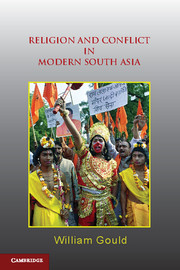Book contents
- Frontmatter
- Contents
- Abbreviations
- Glossary
- Acknowledgements
- 1 Introduction
- 2 Building Spheres of Community
- 3 Transforming Spheres of Community
- 4 Defining Spheres of Community
- 5 State Transformation, Democracy and Conflict
- 6 Forging National Consensus and Containing Pluralism
- 7 New Conflicts and Old Rivalries
- 8 The Resurgence of Communalism?
- Conclusion
- Bibliography
- Index
- References
7 - New Conflicts and Old Rivalries
The 1970s and 1980s
Published online by Cambridge University Press: 05 June 2012
- Frontmatter
- Contents
- Abbreviations
- Glossary
- Acknowledgements
- 1 Introduction
- 2 Building Spheres of Community
- 3 Transforming Spheres of Community
- 4 Defining Spheres of Community
- 5 State Transformation, Democracy and Conflict
- 6 Forging National Consensus and Containing Pluralism
- 7 New Conflicts and Old Rivalries
- 8 The Resurgence of Communalism?
- Conclusion
- Bibliography
- Index
- References
Summary
On the morning of 31 October 1984, Indira Gandhi set out from her prime-ministerial residence at 1 Safdarjung Road, New Delhi, to attend an interview with Peter Ustinov. As she passed through the gardens of the house, two of her Sikh bodyguards, Beant Singh and Satwant Singh, opened fire, spinning the Prime Minister of India around and leaving her prone and bleeding on the ground, after which multiple rounds of ammunition were fired at her immobile body. Although there was an ambulance on site, nobody could find the driver. Sonia Gandhi and Indira Gandhi’s aides lifted her into a Hindustani Ambassador and she was rushed to the All India Institute of Medical Sciences, which held a special supply of her ‘O’ blood group Rh. negative. Meanwhile, the two arrested Sikhs were shot by their guards. Although attempts were made to remove some of the bullets, Indira Gandhi was pronounced dead by the early afternoon of the same day.
The killing of Indira Gandhi illustrated in a brutal and dramatic way the interconnection between the violence of the locality – the indignation of Delhi’s Sikh community – and decision making at the highest levels of the Indian state. Satwant and Beant Singh (who were shot at the scene of the incident) carried out the assassination in revenge for the government’s operation against Sikh militants taking refuge in the grounds of the Golden Temple in Amritsar. Operation Blue Star was the final act in a disastrous policy of central interference in the complex factional divisions within Punjabi Sikh politics, as Indira Gandhi’s regime attempted to subdue the separatist ambitions of a section of its leadership. The assassination of Indira Gandhi had much more disturbing consequences. Over the first week of November 1984, thousands of Sikhs were killed in a pogrom that spread across the main cities of north India and was most pronounced in Delhi and Kanpur. Much of this violence appeared to be spontaneous, but over the following years, a series of official investigations and independent enquiries suggested that it may have been planned. As with the violence around India’s partition, the quotidian was interlaced with the highest levels of state, and the formalities of political rivalry. And the apparent ferocity of popular indignation was not easily unravelled from a sense of political conspiracy.
- Type
- Chapter
- Information
- Religion and Conflict in Modern South Asia , pp. 232 - 268Publisher: Cambridge University PressPrint publication year: 2011



